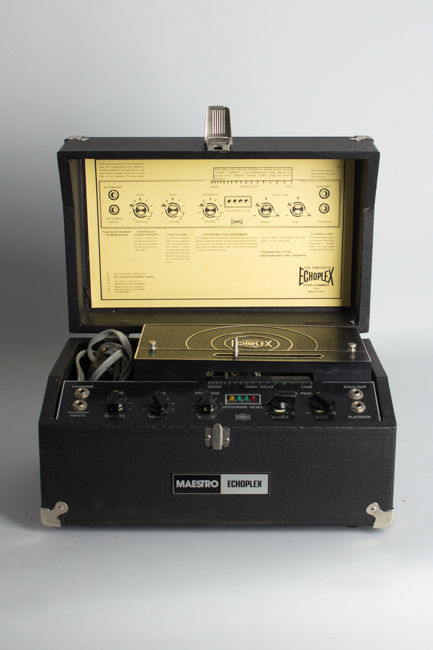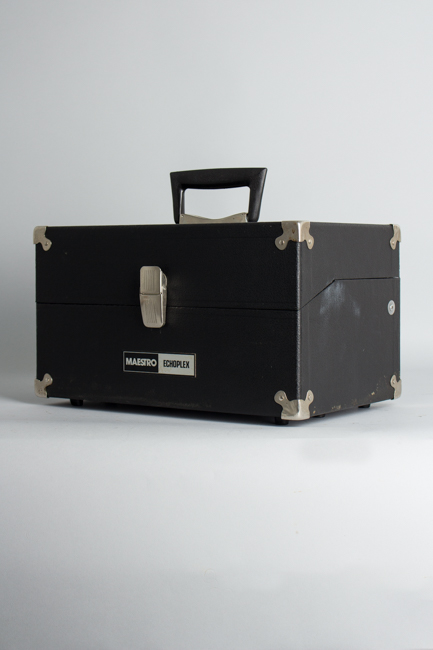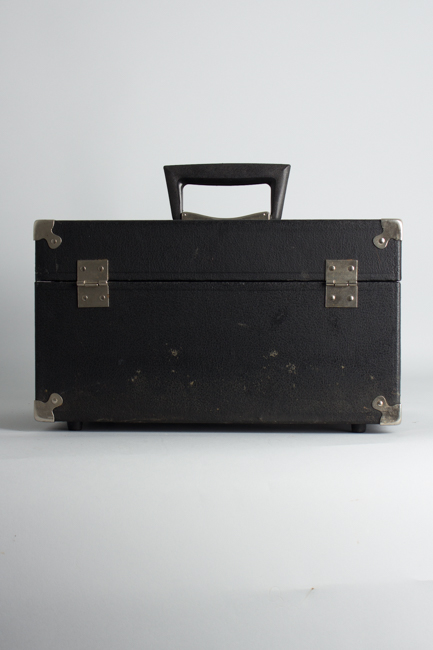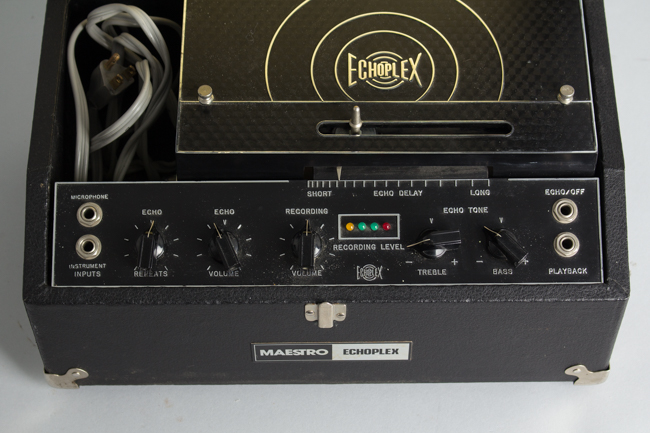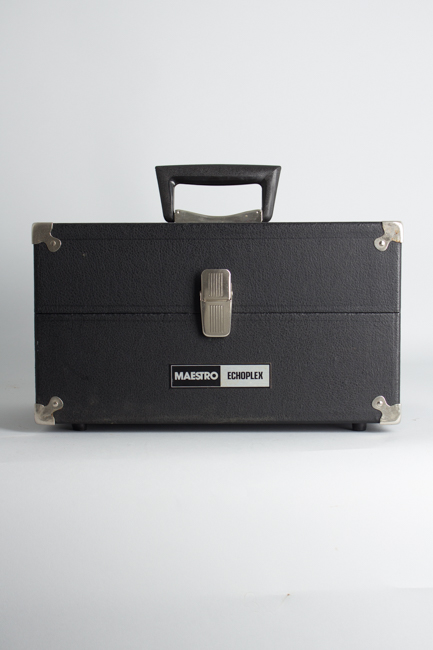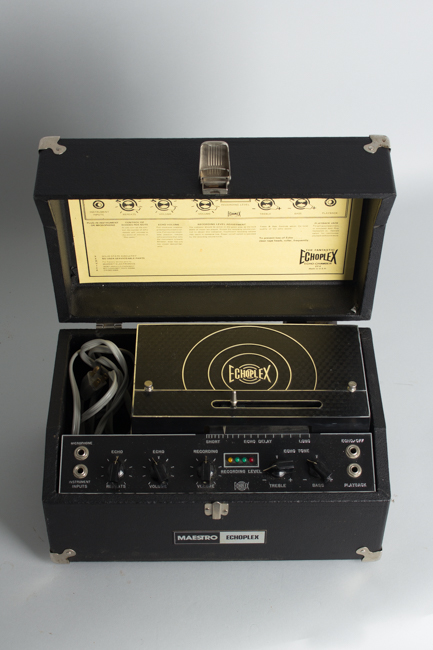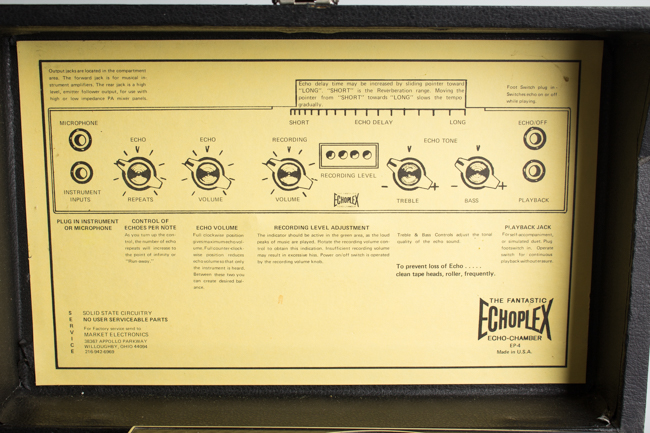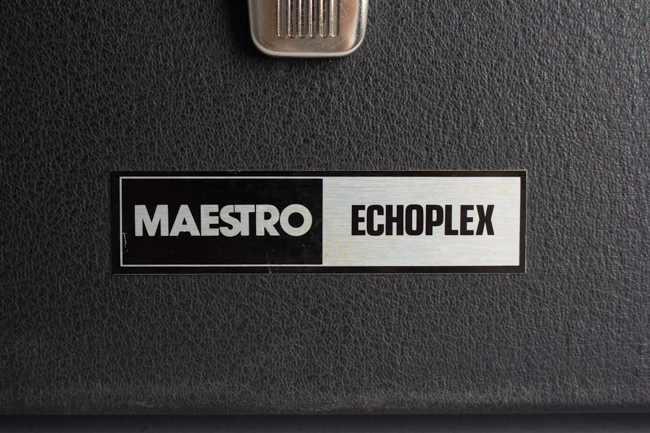Maestro Echoplex EP-4 Echo Effect (1977)
This item has been sold.
Item # 8750
Prices subject to change without notice.
Maestro Echoplex EP-4 Model Echo Effect (1977), made in Willoughby, Ohio, Black Tolex finish.
The Maestro Echoplex is the delay unit that set the standard for these effects, and to many still has never been bettered. The Echoplex emerged from Ohio in the early 1960s, coming on the heels of the 1950s Echosonic amplifier (which had the tape unit built in) and the California-made Ecco-Fonic which was portable but proved glitchy in operation. When it was first built, the original tube-driven Echoplex was not only far more reliable in operation than earlier attempts, but great-sounding as well.
Designed primarily by Mike Battle, the Echoplex was originally built and distributed by a small company called Market Electronics in Ohio. CMI-Gibson's Maestro division later took over the marketing and distribution, although the units were still built in Ohio. Fairly compact and housed in a sturdy box, the Echoplex was the first truly gig-worthy tape echo and became a very popular item, as crucial to many '60s and '70s performers as their guitar and amp.
The Echoplex subsequently went through several iterations, from the classic Tube EP-2 to becoming a solid-state design in the early '70s called the EP-3. By the mid-1970s, Market created an upgrade designated the EP-4. This was the final variant and included several design changes, some better than others. This version is distinguished by an LED "record input" meter on the face, and is also notable for dropping a sound-on-sound feature, which in an era of cheap tape recorders was considered outdated.
It features independent Microphone and Instrument inputs, as well as two separate inputs for a footswitch (not included) labeled the Echo On/Off and Playback inputs. The Echo Delay Control is a sliding post on the top common to all versions which adjusts the length of delay on the echo. Echo Repeats and Echo Volume knobs work independently to control the intensity. The tone of the return can be altered with the Treble and Bass knobs, which is a useful feature specific to the EP-4.
The EP-4 also has an added output buffer to help improve impedance matching with other equipment. Early versions had a built-in compressor board added to the record circuit for a short while; this proved unpopular and Norlin actually issued instructions on how to remove it! Although the 1970s EP-4 is not considered the "holy grail" of Echoplexes, even in this later form it is one of the coolest effects processors ever made, with a lot of flexibility and a sound all its own.
Height is 8 in. (20.3 cm.), 14 1/2 in. (36.8 cm.) width, and 9 in. (22.9 cm.) deep.
This is a very clean unit overall, and looks all original down to the factory tape cartridge which is dated to 1977. The covering of the bottom and lower edges of the box show some scruff, but in general this unit looks only lightly used. It is a very nice example of the final original Echoplex; not the best loved version of this tape-driven classic perhaps, but still an exceptional piece of equipment. Excellent Condition.
The Maestro Echoplex is the delay unit that set the standard for these effects, and to many still has never been bettered. The Echoplex emerged from Ohio in the early 1960s, coming on the heels of the 1950s Echosonic amplifier (which had the tape unit built in) and the California-made Ecco-Fonic which was portable but proved glitchy in operation. When it was first built, the original tube-driven Echoplex was not only far more reliable in operation than earlier attempts, but great-sounding as well.
Designed primarily by Mike Battle, the Echoplex was originally built and distributed by a small company called Market Electronics in Ohio. CMI-Gibson's Maestro division later took over the marketing and distribution, although the units were still built in Ohio. Fairly compact and housed in a sturdy box, the Echoplex was the first truly gig-worthy tape echo and became a very popular item, as crucial to many '60s and '70s performers as their guitar and amp.
The Echoplex subsequently went through several iterations, from the classic Tube EP-2 to becoming a solid-state design in the early '70s called the EP-3. By the mid-1970s, Market created an upgrade designated the EP-4. This was the final variant and included several design changes, some better than others. This version is distinguished by an LED "record input" meter on the face, and is also notable for dropping a sound-on-sound feature, which in an era of cheap tape recorders was considered outdated.
It features independent Microphone and Instrument inputs, as well as two separate inputs for a footswitch (not included) labeled the Echo On/Off and Playback inputs. The Echo Delay Control is a sliding post on the top common to all versions which adjusts the length of delay on the echo. Echo Repeats and Echo Volume knobs work independently to control the intensity. The tone of the return can be altered with the Treble and Bass knobs, which is a useful feature specific to the EP-4.
The EP-4 also has an added output buffer to help improve impedance matching with other equipment. Early versions had a built-in compressor board added to the record circuit for a short while; this proved unpopular and Norlin actually issued instructions on how to remove it! Although the 1970s EP-4 is not considered the "holy grail" of Echoplexes, even in this later form it is one of the coolest effects processors ever made, with a lot of flexibility and a sound all its own.
Height is 8 in. (20.3 cm.), 14 1/2 in. (36.8 cm.) width, and 9 in. (22.9 cm.) deep.
This is a very clean unit overall, and looks all original down to the factory tape cartridge which is dated to 1977. The covering of the bottom and lower edges of the box show some scruff, but in general this unit looks only lightly used. It is a very nice example of the final original Echoplex; not the best loved version of this tape-driven classic perhaps, but still an exceptional piece of equipment. Excellent Condition.
